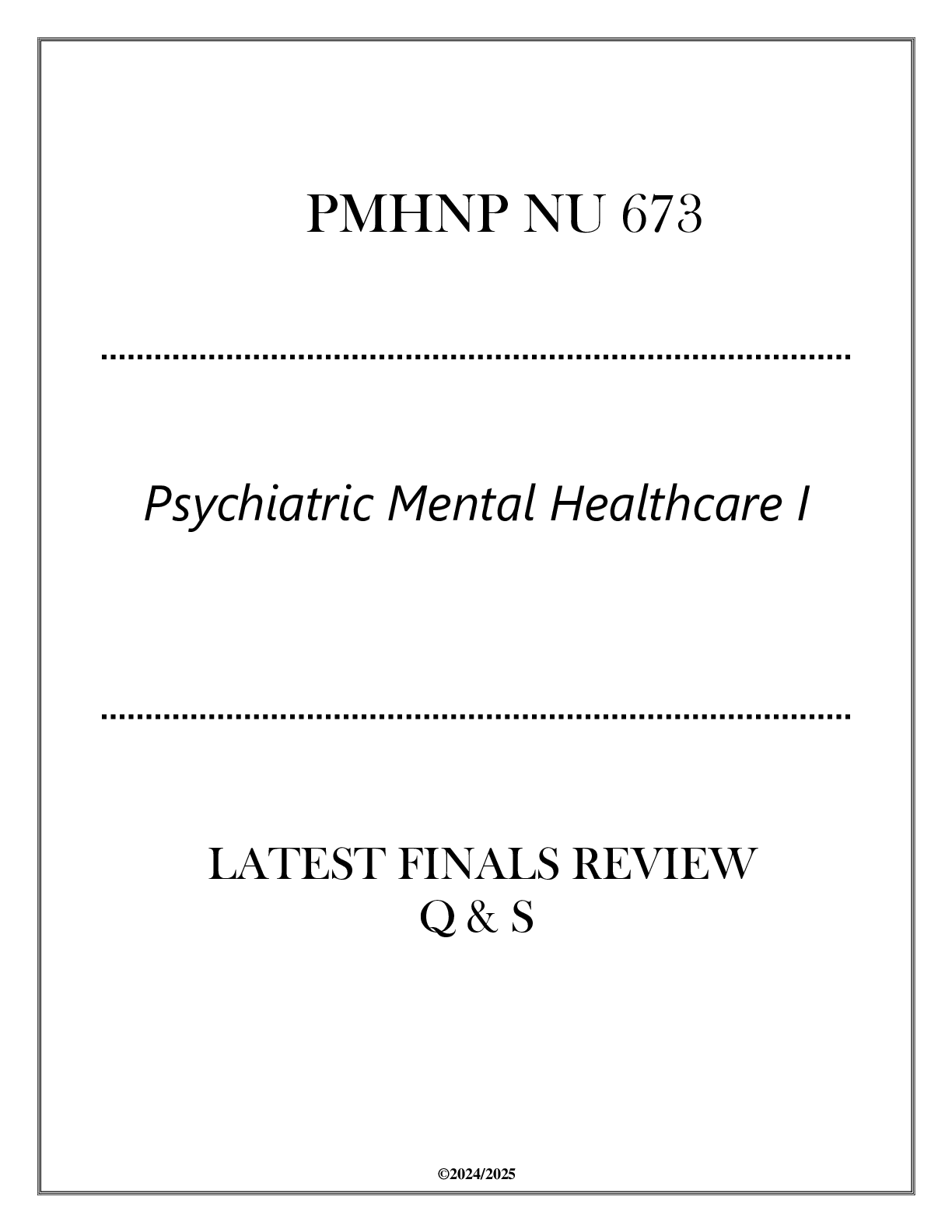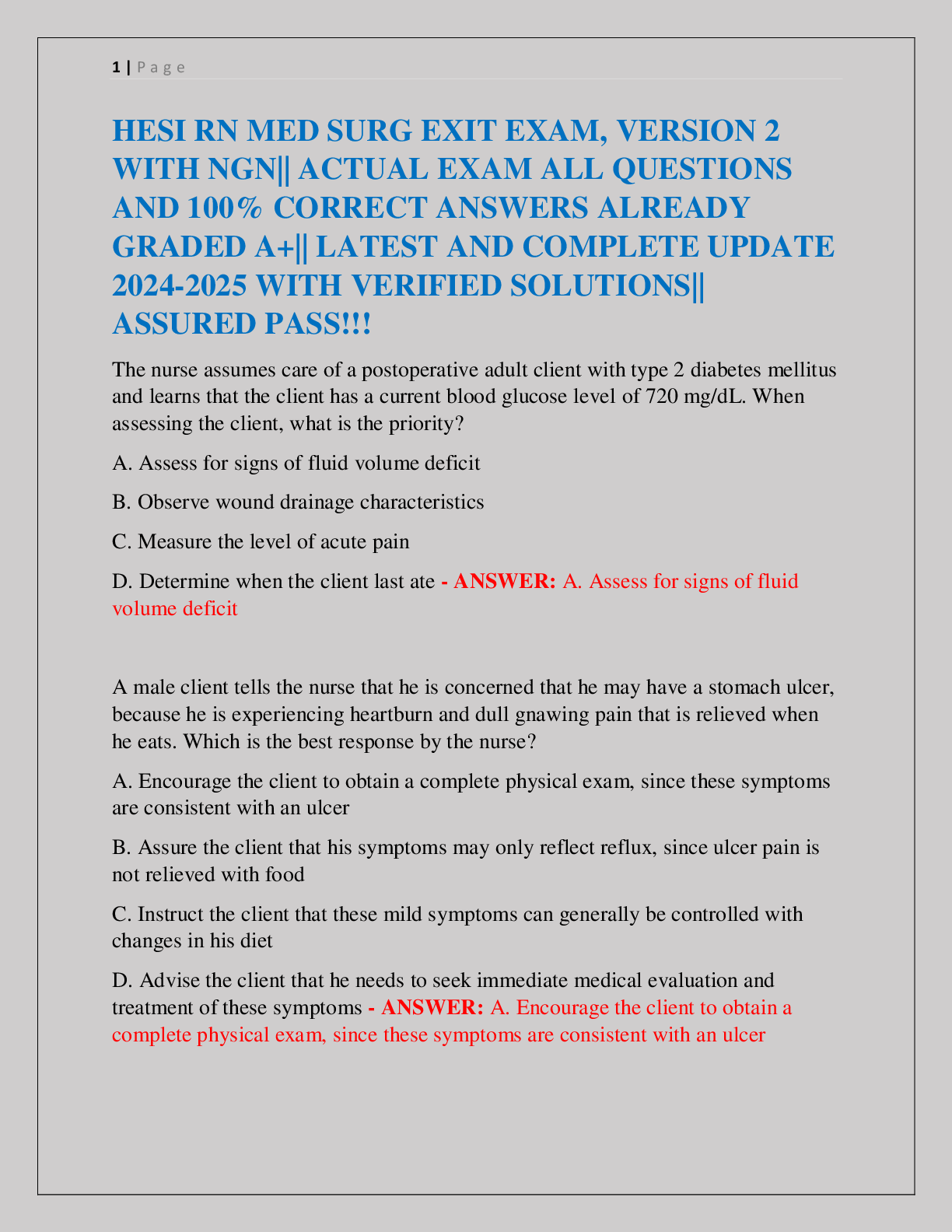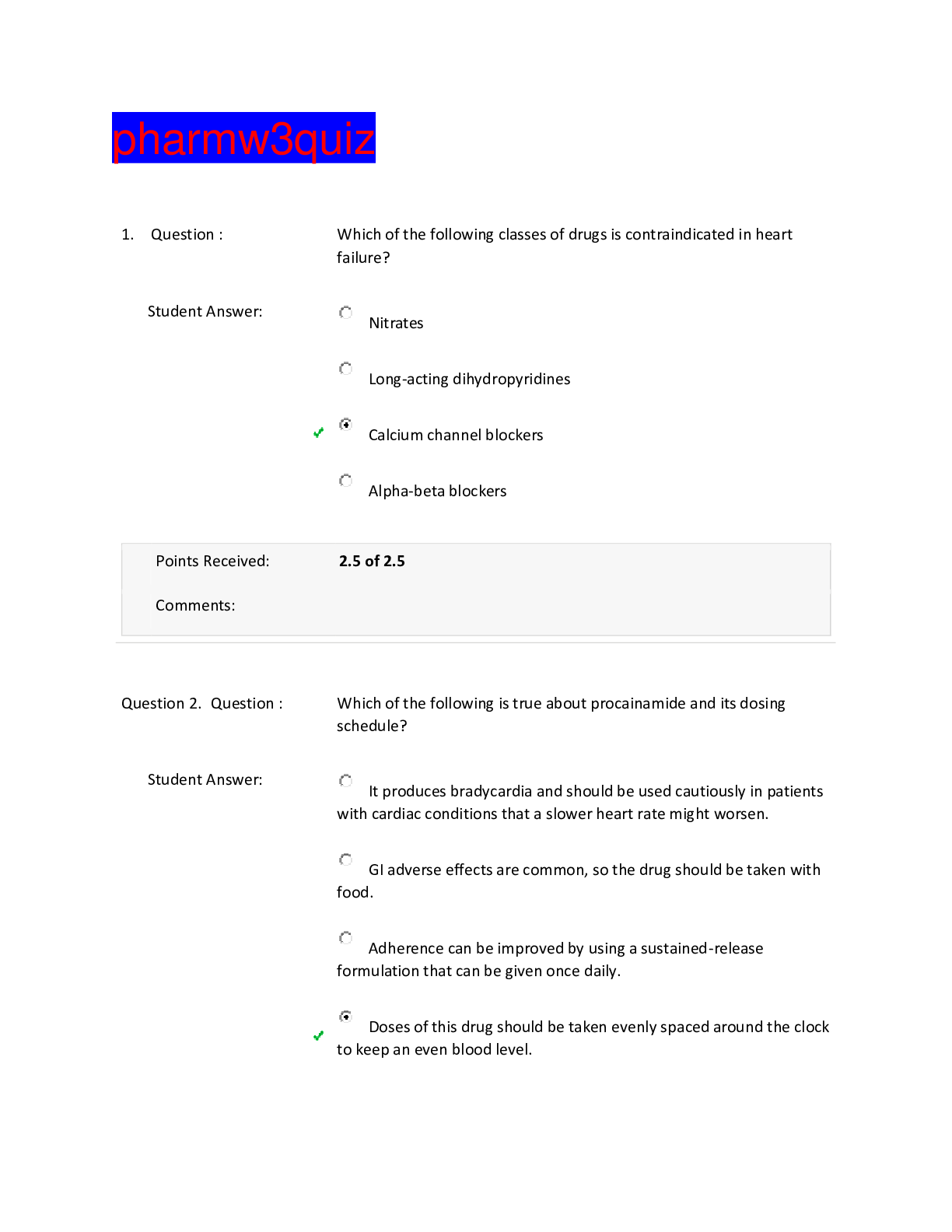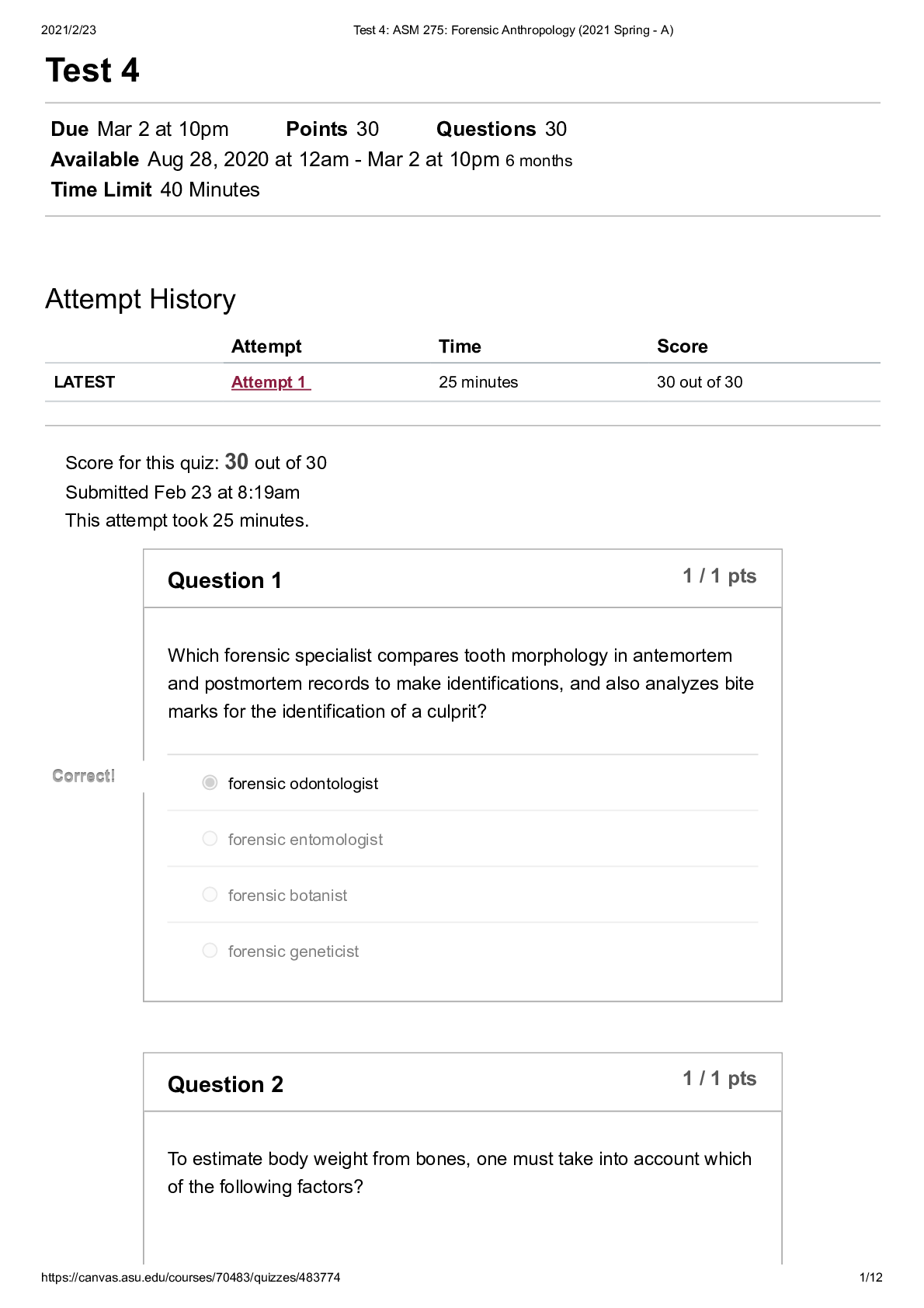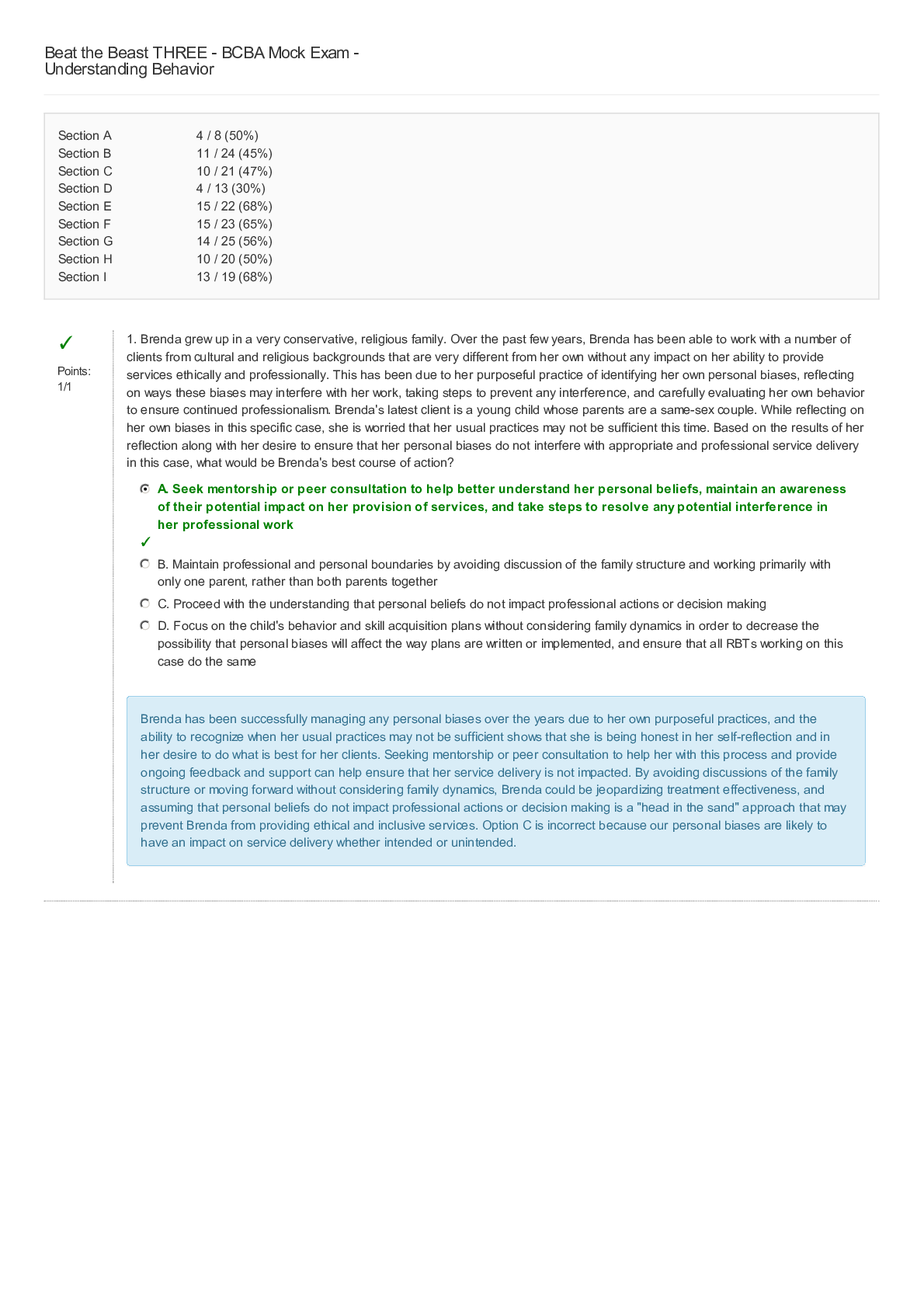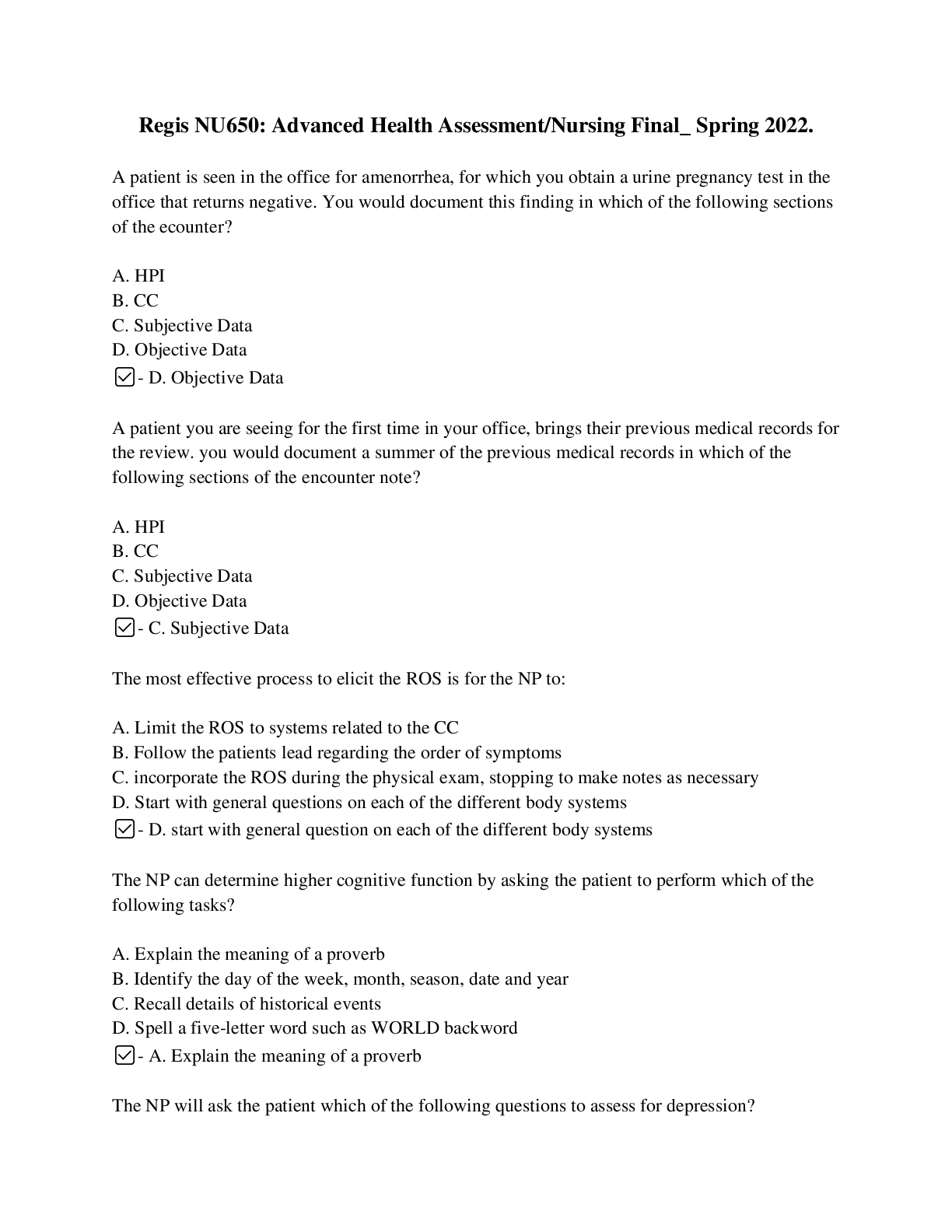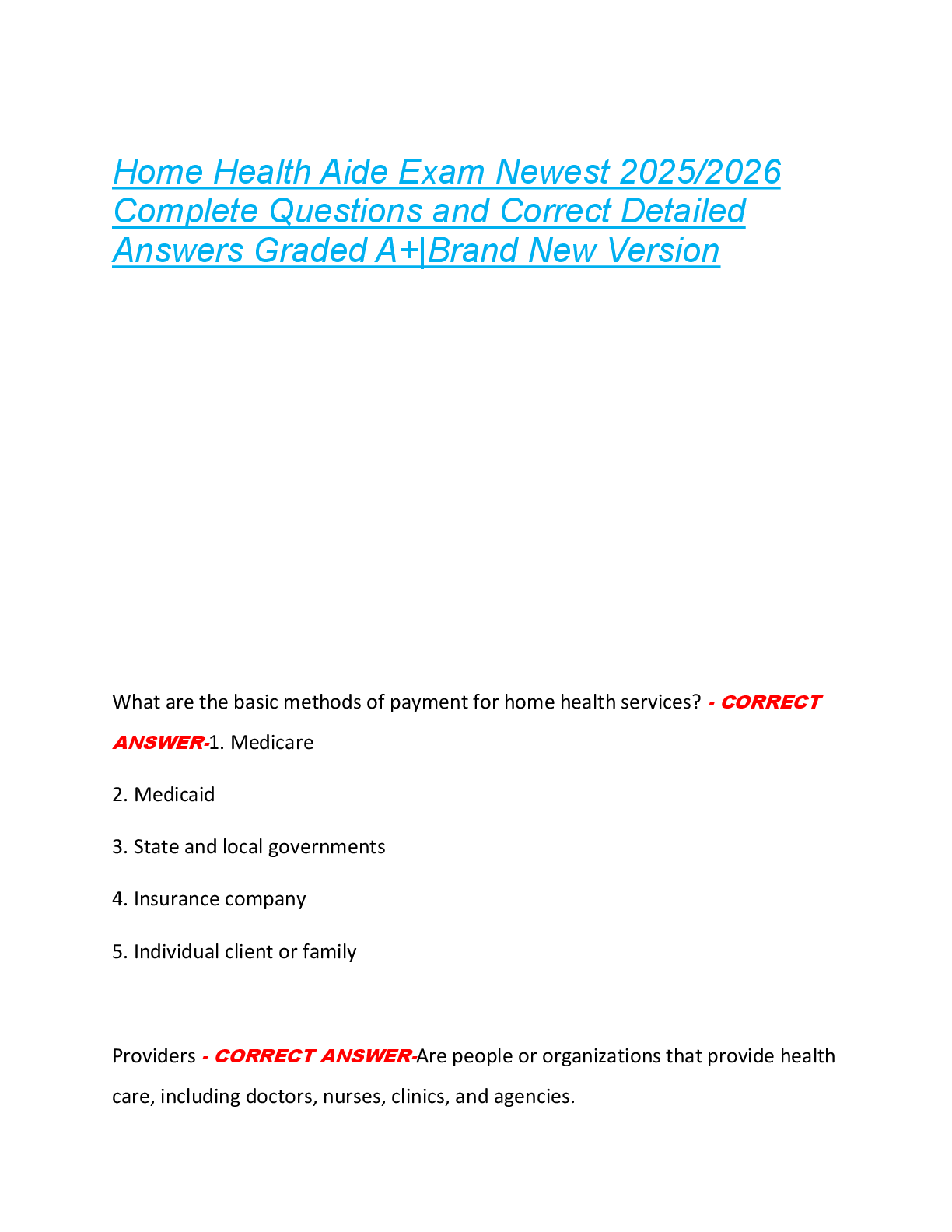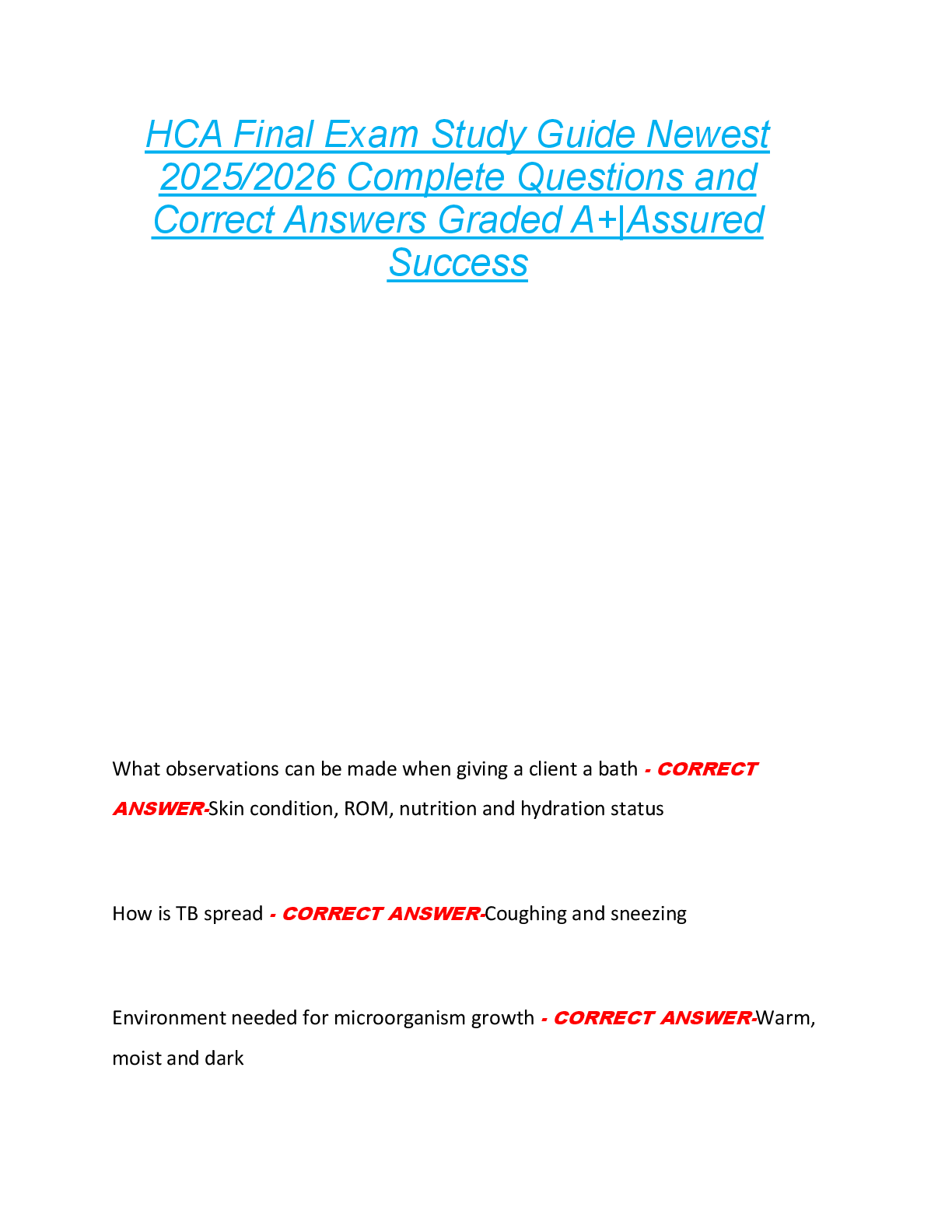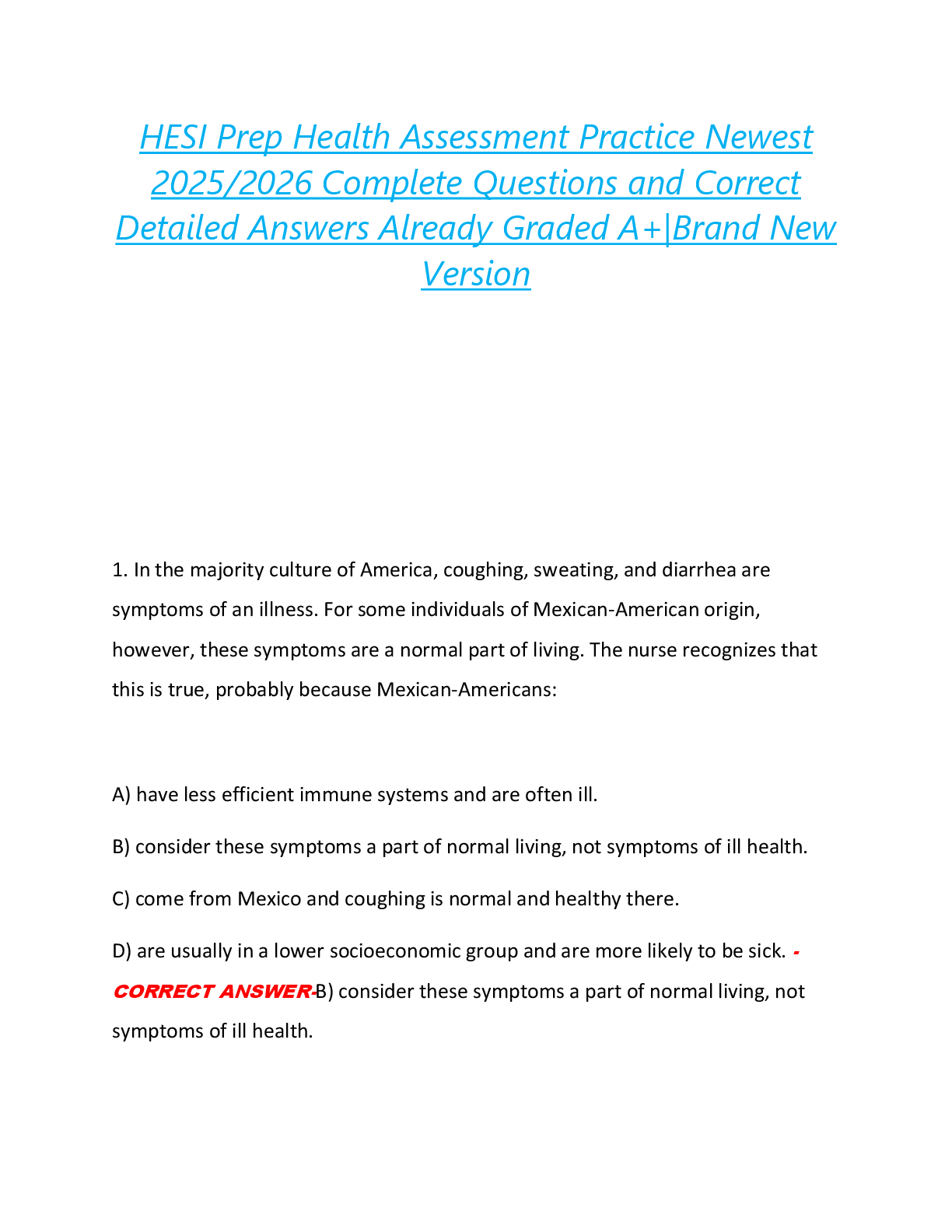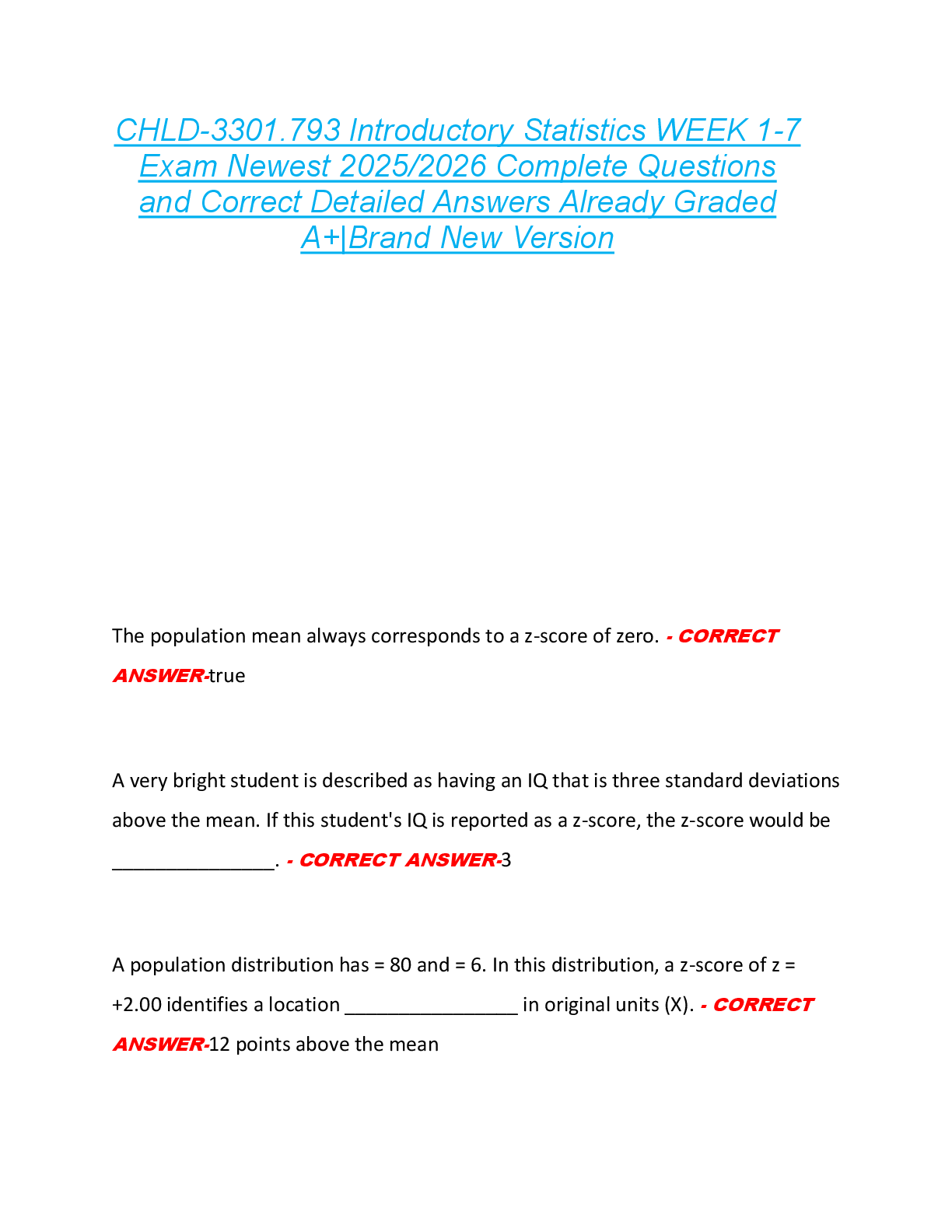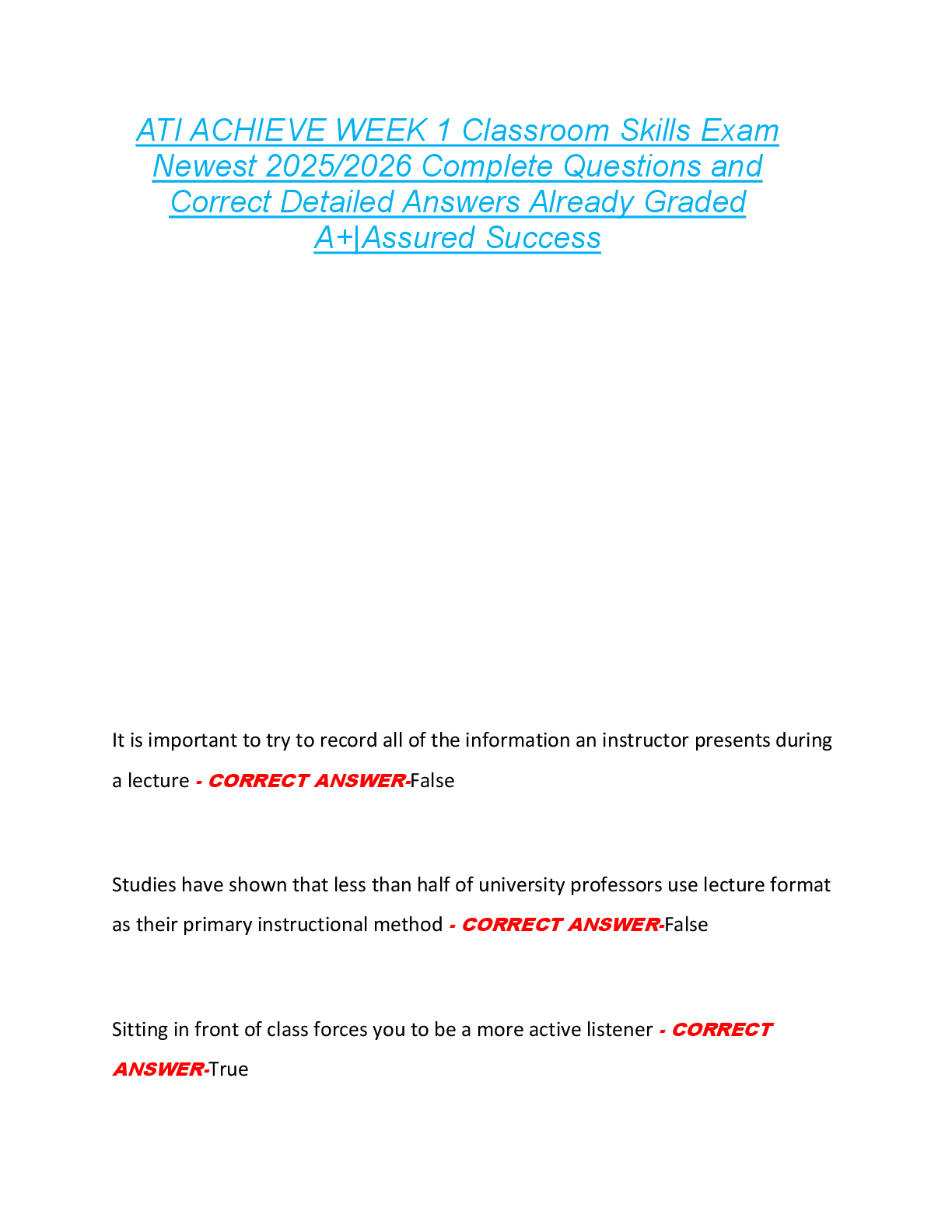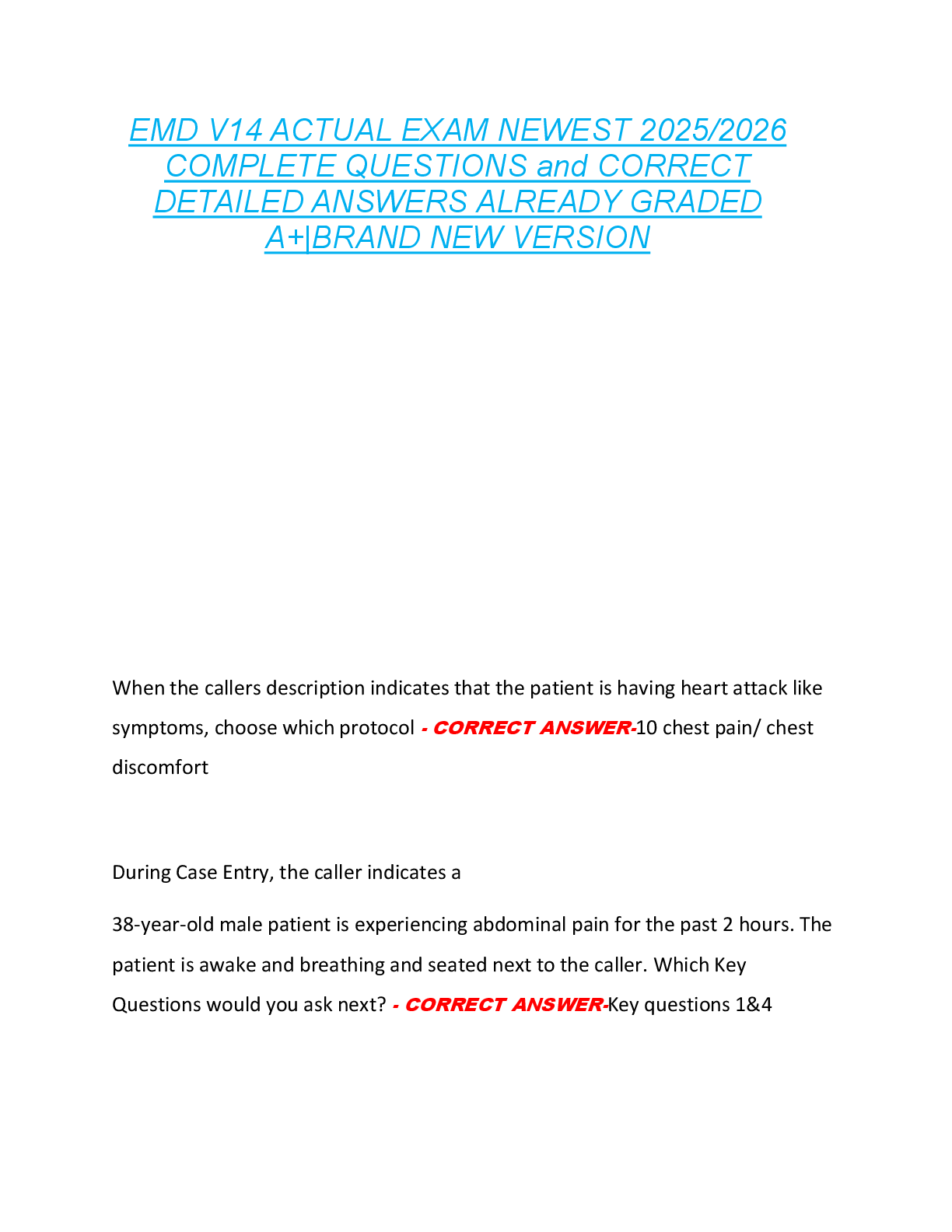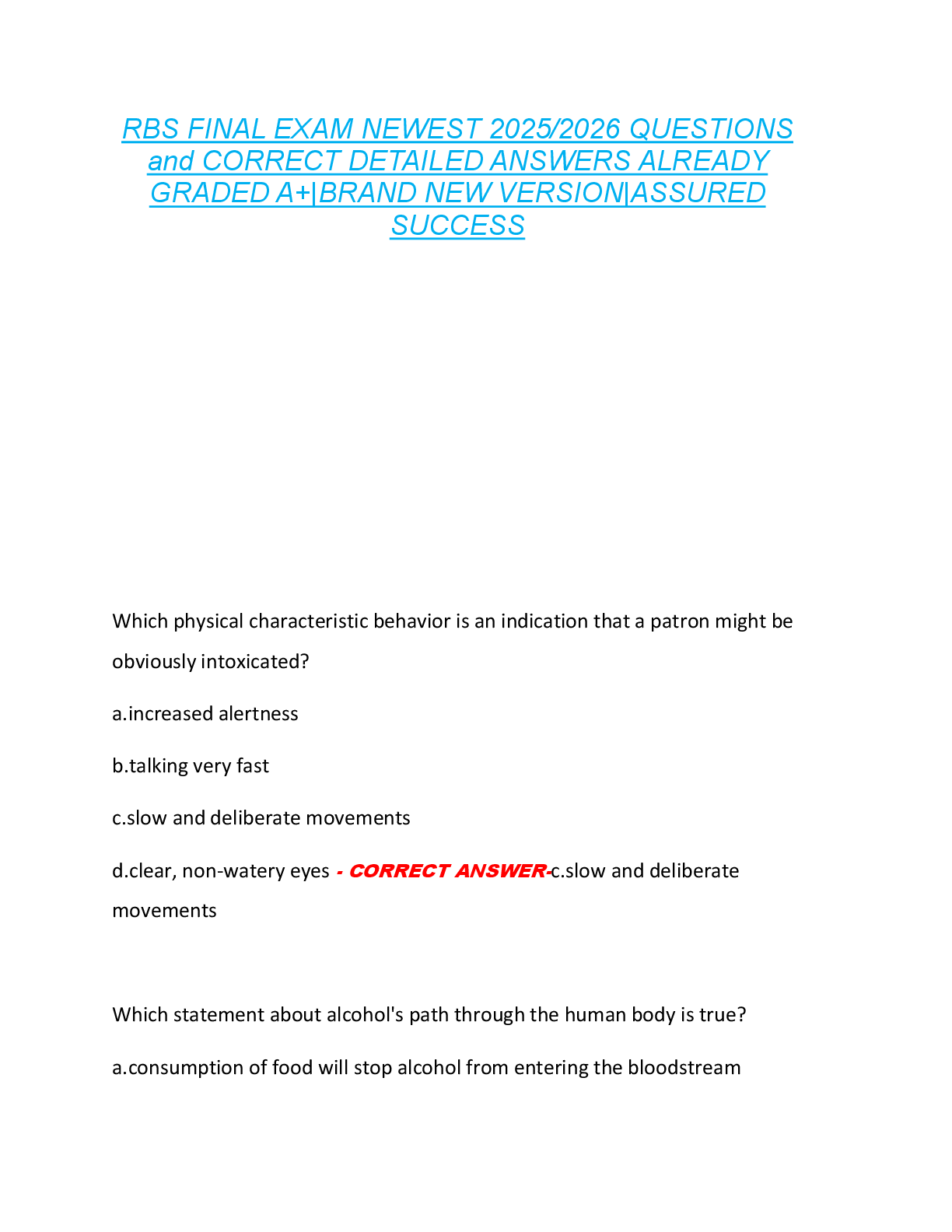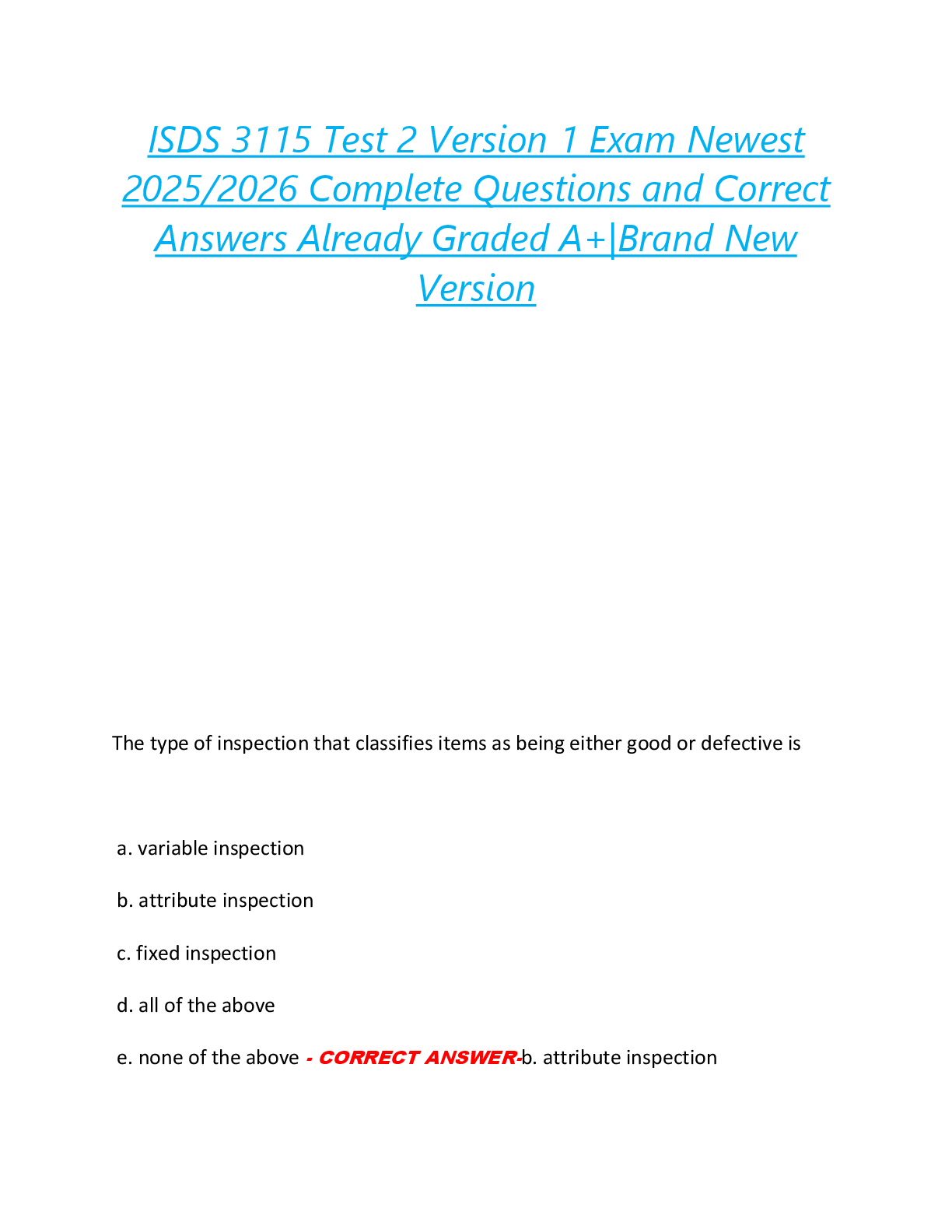NUR 2790 Final Exam Questions & Answers / NUR 2790 Final Exam Complete Solution
Document Content and Description Below
Final Exam Questions (NUR 2790)
CHAPTER 51: CARE OF PATIENTS WITH MUSCULOSKELETAL TRAUMA (30% OF FINAL EXAM)
MULTIPLE CHOICE
1. A nurse assesses a client with a fracture who is being treated with
...
skeletal traction. Which assessment should alert the nurse to urgently contact the health provider?
a. Blood pressure increases to 130/86 mm Hg
b. Traction weights are resting on the floor
c. Oozing of clear fluid is noted at the pin site
d. Capillary refill is less than 3 seconds
2. A nurse coordinates care for a client with a wet plaster cast. Which statement should the nurse include when delegating care for this client to an unlicensed assistive personnel (UAP)?
a. Assess distal pulses for potential compartment syndrome.
b. Turn the client every 3 to 4 hours to promote cast drying.
c. Use a cloth-covered pillow to elevate the clients leg.
d. Handle the cast with your fingertips to prevent indentations.
3. A nurse obtains the health history of a client with a fractured femur. Which factor identified in the clients history should the nurse recognize as an aspect that may impede healing of the fracture?
a. Sedentary lifestyle
b. A 30 pack-year smoking history
c. Prescribed oral contraceptives
d. Pagets disease
4. An emergency department nurse cares for a client who sustained a crush injury to the right lower leg. The client reports numbness and tingling in the affected leg. Which action should the nurse take first?
a. Assess the pedal pulses.
b. Apply oxygen by nasal cannula.
c. Increase the IV flow rate.
d. Loosen the traction.
5. A nurse assesses an older adult client who was admitted 2 days ago with a fractured hip. The nurse notes that the client is confused and restless. The clients vital signs are heart rate 98 beats/min, respiratory rate 32 breaths/min, blood pressure 132/78 mm Hg, and SpO2 88%. Which action should the nurse take first?
a. Administer oxygen via nasal cannula.
b. Re-position to a high-Fowlers position.
c. Increase the intravenous flow rate.
d. Assess response to pain medications.
6. A trauma nurse cares for several clients with fractures. Which client should the nurse identify as at highest risk for developing deep vein thrombosis?
a. An 18-year-old male athlete with a fractured clavicle
b. A 36-year old female with type 2 diabetes and fractured ribs
c. A 55-year-old woman prescribed aspirin for rheumatoid arthritis
d. A 74-year-old man who smokes and has a fractured pelvis
7. A nurse delegates care of a client in traction to an unlicensed assistive personnel (UAP). Which statement should the nurse include when delegating hygiene care for this client?
a. Remove the traction when re-positioning the client.
b. Inspect the clients skin when performing a bed bath.
c. Provide pin care by using alcohol wipes to clean the sites.
d. Ensure that the weights remain freely hanging at all times.
8. A nurse notes crepitation when performing range-of-motion exercises on a client with a fractured left humerus. Which action should the nurse take next?
a. Immobilize the left arm.
b. Assess the clients distal pulse.
c. Monitor for signs of infection.
d. Administer prescribed steroids.
9. A nurse reviews prescriptions for an 82-year-old client with a fractured left hip. Which prescription should alert the nurse to contact the provider and express concerns for client safety?
a. Meperidine (Demerol) 50 mg IV every 4 hours
b. Patient-controlled analgesia (PCA) with morphine sulfate
c. Percocet 2 tablets orally every 6 hours PRN for pain
d. Ibuprofen elixir every 8 hours for first 2 days
10. A nurse is caring for a client who is recovering from an above-the-knee amputation. The client reports pain in the limb that was removed. How should the nurse respond?
a. The pain you are feeling does not actually exist.
b. This type of pain is common and will eventually go away.
c. Would you like to learn how to use imagery to minimize your pain?
d. How would you describe the pain that you are feeling?
11. A home health nurse assesses a client with diabetes who has a new cast on the arm. The nurse notes the clients fingers are pale, cool, and slightly swollen. Which action should the nurse take first?
a. Raise the arm above the level of the heart.
b. Encourage range of motion.
c. Apply heat to the affected hand.
d. Bivalve the cast to decrease pressure.
12. A nurse cares for a client who had a wrist cast applied 3 days ago. The client states, the cast is loose enough to slide off. How should the nurse respond?
a. Keep your arm above the level of your heart.
b. As your muscles atrophy, the cast is expected to loosen.
c. I will wrap a bandage around the cast to prevent it from slipping.
d. You need a new cast now that the swelling is decreased.
13. A nurse assesses a client with a pelvic fracture. Which assessment finding should the nurse identify as a complication of this injury?
a. Hypertension
b. Constipation
c. Infection
d. Hematuria
14. A nurse cares for a client placed in skeletal traction. The client asks, what is the primary purpose of this type of traction? How should the nurse respond?
a. Skeletal traction will assist in realigning your fractured bone.
b. This treatment will prevent future complications and back pain.
c. Traction decreases muscle spasms that occur with a fracture.
d. This type of traction minimizes damage as a result of fracture treatment.
15. A nurse cares for a client in skeletal traction. The nurse notes that the skin around the clients pin sites is swollen, red, and crusty with dried drainage. Which action should the nurse take next?
a. Request a prescription to decrease the traction weight.
b. Apply an antibiotic ointment and a clean dressing.
c. Cleanse the area, scrubbing off the crusty areas.
d. Obtain a prescription to culture the drainage.
16. A nurse cares for a client recovering from an above-the-knee amputation of the right leg. The client reports pain in the right foot. Which prescribed medication should the nurse administer first?
a. Intravenous morphine
b. Oral acetaminophen
c. Intravenous calcitonin
d. Oral ibuprofen
17. A nurse plans care for a client who is recovering from a below-the-knee amputation of the left leg. Which intervention should the nurse include in this clients plan of care?
a. Place pillows between the clients knees.
b. Encourage range-of-motion exercises.
c. Administer prophylactic antibiotics.
d. Implement strict bedrest in a supine position.
18. An emergency department nurse triages a client with diabetes mellitus who has fractured her arm. Which action should the nurse take first?
a. Remove the medical alert bracelet from the fractured arm.
b. Immobilize the arm by splinting the fractured site.
c. Place the client in a supine position with a warm blanket.
d. Cover any open areas with a sterile dressing.
19. A nurse assesses a client with a rotator cuff injury. Which finding should the nurse expect to assess?
a. Inability to maintain adduction of the affected arm for more than 30 seconds
b. Shoulder pain that is relieved with overhead stretches and at night
c. Inability to initiate or maintain abduction of the affected arm at the shoulder
d. Referred pain to the shoulder and arm opposite the affected shoulder
20. A nurse cares for a client with a fractured fibula. Which assessment should alert the nurse to take immediate action?
a. Pain of 4 on a scale of 0 to 10
b. Numbness in the extremity
c. Swollen extremity at the injury site
d. Feeling cold while lying in bed
21. After teaching a client with a fractured humerus, the nurse assesses the clients understanding. Which dietary choice demonstrates that the client correctly understands the nutrition needed to assist in healing the fracture?
a. Baked fish with orange juice and a vitamin D supplement
b. Bacon, lettuce, and tomato sandwich with a vitamin B supplement
c. Vegetable lasagna with a green salad and a vitamin A supplement
d. Roast beef with low-fat milk and a vitamin C supplement
22. A nurse cares for an older adult client with multiple fractures. Which action should the nurse take to manage this clients pain?
a. Meperidine (Demerol) injections every 4 hours around the clock
b. Patient-controlled analgesia (PCA) pump with morphine
c. Ibuprofen (Motrin) 600 mg orally every 4 hours PRN for pain
d. Morphine 4 mg intravenous push every 2 hours PRN for pain
23. A phone triage nurse speaks with a client who has an arm cast. The client states, My arm feels really tight and puffy. How should the nurse respond?
a. Elevate your arm on two pillows and get ice to apply to the cast.
b. Continue to take ibuprofen (Motrin) until the swelling subsides.
c. This is normal. A new cast will often feel a little tight for the first few days.
d. Please come to the clinic today to have your arm checked by the provider.
24. A nurse cares for a client who had a long-leg cast applied last week. The client states, I cannot seem to catch my breath and I feel a bit light-headed. Which action should the nurse take next?
a. Auscultate the clients lung fields anteriorly and posteriorly.
b. Administer oxygen to keep saturations greater than 92%.
c. Check the clients blood glucose level.
d. Ask the client to take deep breaths.
25. A nurse cares for an older adult client who is recovering from a leg amputation surgery. The client states, I dont want to live with only one leg. I should have died during the surgery. How should the nurse respond?
a. Your vital signs are good, and you are doing just fine right now.
b. Your children are waiting outside. Do you want them to grow up without a father?
c. This is a big change for you. What support system do you have to help you cope?
d. You will be able to do some of the same things as before you became disabled.
26. After teaching a client who is recovering from a vertebroplasty, the nurse assesses the clients understanding. Which statement by the client indicates a need for additional teaching?
a. I can drive myself home after the procedure.
b. I will monitor the puncture site for signs of infection.
c. I can start walking tomorrow and increase my activity slowly.
d. I will remove the dressing the day after discharge.
27. A nurse plans care for a client who is prescribed skeletal traction. Which intervention should the nurse include in this plan of care to decrease the clients risk for infection?
a. Wash the traction lines and sockets once a day.
b. Release traction tension for 30 minutes twice a day.
c. Do not place the traction weights on the floor.
d. Schedule for pin care to be provided every shift.
.
MULTIPLE RESPONSE
1. A nurse teaches a client with a fractured tibia about external fixation. Which advantages of external fixation for the immobilization of fractures should the nurse share with the client? (Select all that apply.)
a. It leads to minimal blood loss.
b. It allows for early ambulation.
c. It decreases the risk of infection.
d. It increases blood supply to tissues.
e. It promotes healing.
2. An emergency nurse assesses a client who is admitted with a pelvic fracture. Which assessments should the nurse monitor to prevent a complication of this injury? (Select all that apply.)
a. Temperature
b. Urinary output
c. Blood pressure
d. Pupil reaction
e. Skin color
3. A nurse cares for a client with a fracture injury. Twenty minutes after an opioid pain medication is administered, the client reports pain in the site of the fracture. Which actions should the nurse take? (Select all that apply.)
a. Administer additional opioids as prescribed.
b. Elevate the extremity on pillows.
c. Apply ice to the fracture site.
d. Place a heating pad at the site of the injury.
e. Keep the extremity in a dependent position.
4. A nurse plans care for a client who is recovering from open reduction and internal fixation (ORIF) surgery for a right hip fracture. Which interventions should the nurse include in this clients plan of care? (Select all that apply.)
a. Elevate heels off the bed with a pillow.
b. Ambulate the client on the first postoperative day.
c. Push the clients patient-controlled analgesia button.
d. Re-position the client every 2 hours.
e. Use pillows to encourage subluxation (dislocation) of the hip.
5. A nurse assesses a client with a cast for potential compartment syndrome. Which clinical manifestations are correctly paired with the physiologic changes of compartment syndrome? (Select all that apply.)
a. Edema Increased capillary permeability
b. Pallor Increased blood blow to the area
c. Unequal pulses Increased production of lactic acid
d. Cyanosis Anaerobic metabolism
e. Tingling A release of histamine
PHYSIOLOGIC CHANGE CLINICAL FINDINGS
Increased compartment pressure
Increased capillary permeability
Release of histamine
Increased blood flow to area
Pressure on nerve endings
Increased tissue pressure
Decreased tissue perfusion
Decreased oxygen to tissues
Increased production of lactic acid
Anaerobic metabolism
Vasodilation
Increased blood flow
Increased tissue pressure
Increased edema
Muscle ischemia
Tissue necrosis
6. A nurse teaches a client who is at risk for carpal tunnel syndrome. Which health promotion activities should the nurse include in this clients teaching? (Select all that apply.)
a. Frequently assess the ergonomics of the equipment being used.
b. Take breaks to stretch fingers and wrists during working hours.
c. Do not participate in activities that require repetitive actions.
d. Take ibuprofen (Motrin) to decrease pain and swelling in wrists.
e. Adjust chair height to allow for good posture.
7. A nurse teaches a client about prosthesis care after amputation. Which statements should the nurse include in this clients teaching? (Select all that apply.)
a. The device has been custom made specifically for you.
b. Your prosthetic is good for work but not for exercising.
c. A prosthetist will clean your inserts for you each month.
d. Make sure that you wear the correct liners with your prosthetic.
e. I have scheduled a follow-up appointment for you.
CHAPTER 60: MUSCULOSKELETAL TRAUMA: NURSING MANAGEMENT OLD BOOK
MULTIPLE CHOICE
1. A client tells the nurse that he has pain, swelling, fatigue, and numbness of his hands. The nurse should assess the client for which of the following occupations?
a. Retail store clerk
b. Lifeguard
c. Computer keyboard operator
d. Bus driver
2. A client who plays baseball on the weekends is experiencing an arm injury. The nurse realizes this client needs to be evaluated for:
a. a rotator cuff tear.
b. lateral epicondylitis.
c. dislocation of the shoulder.
d. patellar tendinopathy.
3. A client, diagnosed with an ankle sprain, is prescribed ibuprofen to control pain and inflammation. What instruction should the client receive concerning this medication?
a. “Bleeding is not a problem with this medication.”
b. “Take on an empty stomach to maximize its effect.”
c. “Take with food to minimize gastrointestinal irritation.”
d. “Wear sunscreen if outside to prevent a burn.”
4. A client, experiencing a fractured arm, asks the nurse why the splint is being applied. Which of the following should the nurse respond to this client?
a. “It reduces the need for a cast.”
b. “It reduces bleeding, swelling and pain.”
c. “It prevents the need for surgery.”
d. “It immobilizes the muscles and joints.”
5. A client has had a cast applied to immobilize a right ulnar fracture. Which of the following nursing interventions is most important?
a. Calling physical therapy for a sling
b. Checking capillary refill time
c. Giving pain medication
d. Starting discharge teaching
6. A client with a right arm cast is experiencing signs of a serious complication. Which of the following would cause the nurse the most concern?
a. Capillary refill time less than 3 seconds
b. Finger movement
c. Itching under the cast
d. Severe pain to the right arm continues after receiving pain medication
7. A client is unable to pass the chair raise test. The nurse realizes this client is experiencing:
a. carpal tunnel syndrome.
b. rotator cuff tear.
c. fractured arm.
d. lateral epicondylitis.
8. A client has been wearing a splint for carpal tunnel syndrome for 7 weeks. The nurse realizes that which of the following would be the next course of treatment for this client?
a. Surgery
b. Exercises
c. Corticosteroid injection
d. Casting
9. The nurse is planning care for a client recovering from a meniscal injury. Which of the following should be included as strategies to avoid future injuries?
a. Avoid hamstring muscle exercises.
b. Stretch before and after exercise.
c. Wear similar shoes for all activities.
d. Avoid skiing.
10. A client with an ankle sprain is instructed to follow RICE. Which of the following should the nurse instruct the client regarding this process?
a. “Maintain your normal level of activity.”
b. “Apply ice to the ankle once a day.”
c. “Apply an elastic bandage to the site.”
d. “Elevate the extremity every day for 20 to 30 minutes.”
11. The nurse is evaluating the effectiveness of care for a client recovering from an injured Achilles tendon. Which of the following would indicate that care has been effective?
a. Client states steroid injections will be helpful to reduce the amount of pain.
b. Client plans to participate in rehabilitation for 5 to 6 months after the injury.
c. Client resumes sports activities as soon as possible.
d. Client uses heat to decrease the inflammation and swelling from the injury.
12. The nurse is instructing a client on ways to prevent the onset of stress fractures. Which of the following should be included in these instructions?
a. Avoid overtraining
b. Increase intensity of training 10% each day
c. Limit warm up exercises
d. Avoid shock absorbing footwear
13. The nurse suspects a client, recovering from hip replacement surgery, is experiencing an infection when which of the following is assessed?
a. Client using crutches to ambulate
b. Blood pressure 110/68 mmHg
c. Pain with movement
d. Foot intact to sensation and motion
MULTIPLE RESPONSE
1. The nurse is concerned that a client is demonstrating signs of compartment syndrome. Which of the following is considered a classical symptom of this disorder? (Select all that apply.)
a. Pain
b. Paraplegia
c. Paresthesia
d. Pink
e. Pressure
f. Pulselessness
2. A client is diagnosed with a pathological fracture. For which of the following disease processes should the nurse assess the client? (Select all that apply.)
a. Cushing’s syndrome
b. Osteomalacia
c. Paget’s disease
d. Heart failure
e. Diabetes mellitus
f. Chronic obstructive pulmonary disease
3. A client, recovering from a fractured pelvis, begins to have dyspnea and restlessness. The nurse is concerned that the client is experiencing a fat emboli when which of the following are assessed? (Select all that apply.)
a. Upper body petechiae
b. Cough
c. Protein in the urine
d. Seizures
e. Temperature 102°F
f. Elevated blood glucose level
4. The nurse is assessing a client recovering from abdominal surgery for the development of a deep vein thrombosis. Which of the following would indicate that the client is experiencing this disorder? (Select all that apply.)
a. Pain and tenderness of the lower extremity
b. Red area on a limb that is warm to the touch
c. Unexplained dyspnea
d. Chest pain
e. Hemoptysis
f. Drop in blood pressure
5. The nurse is planning care for a client recovering from an amputation. Which of the following should be included in this plan of care? (Select all that apply.)
a. Provide pain medication 30 minutes before stump care.
b. Wash the stump daily with mild soap and warm water.
c. Allow the stump to dry open to the air for 10 minutes after washing.
d. Avoid massaging the stump.
e. Elevate the stump on a pillow.
f. Lie prone 10 to 20 minutes every day.
Topics to Review
[Show More]
Last updated: 11 months ago
Preview 3 out of 12 pages
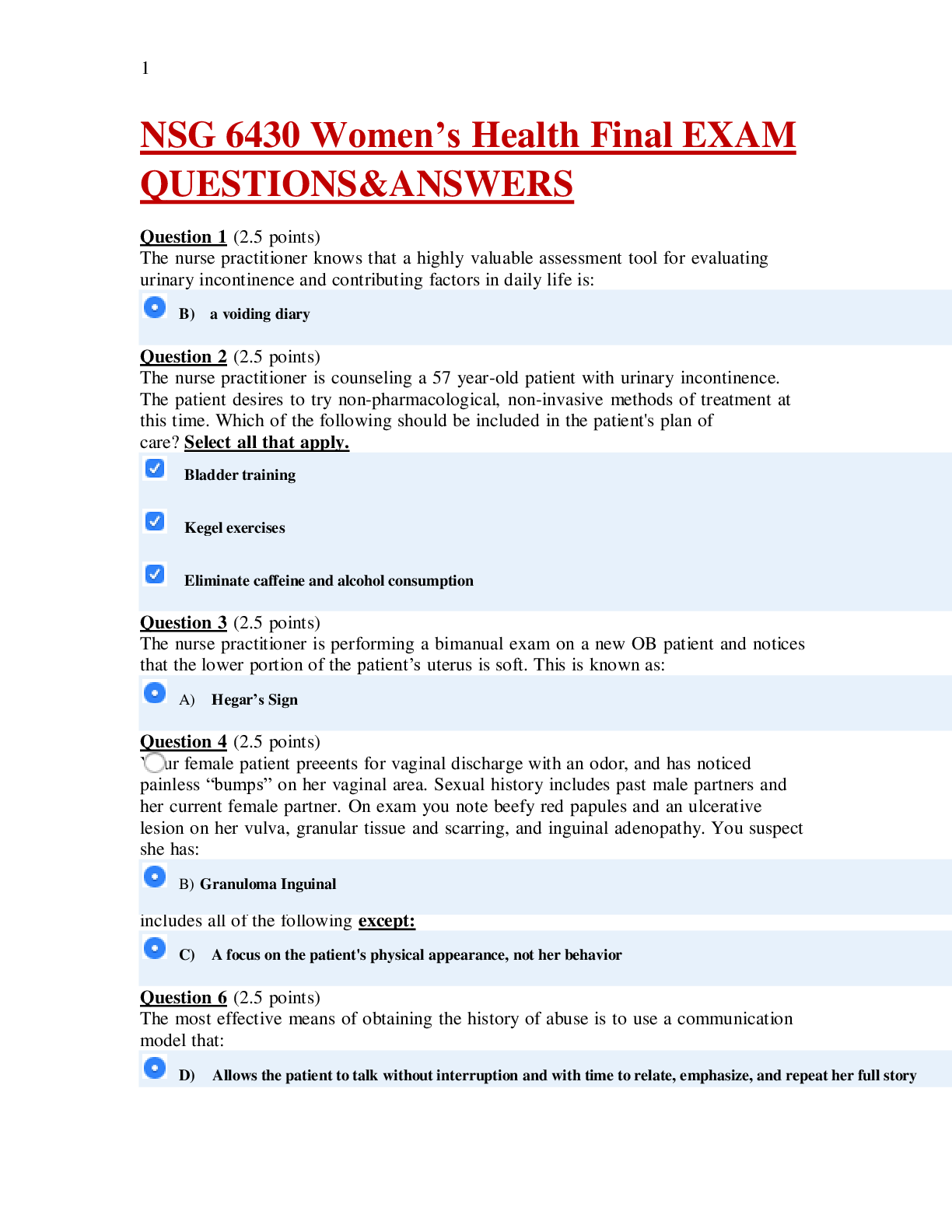







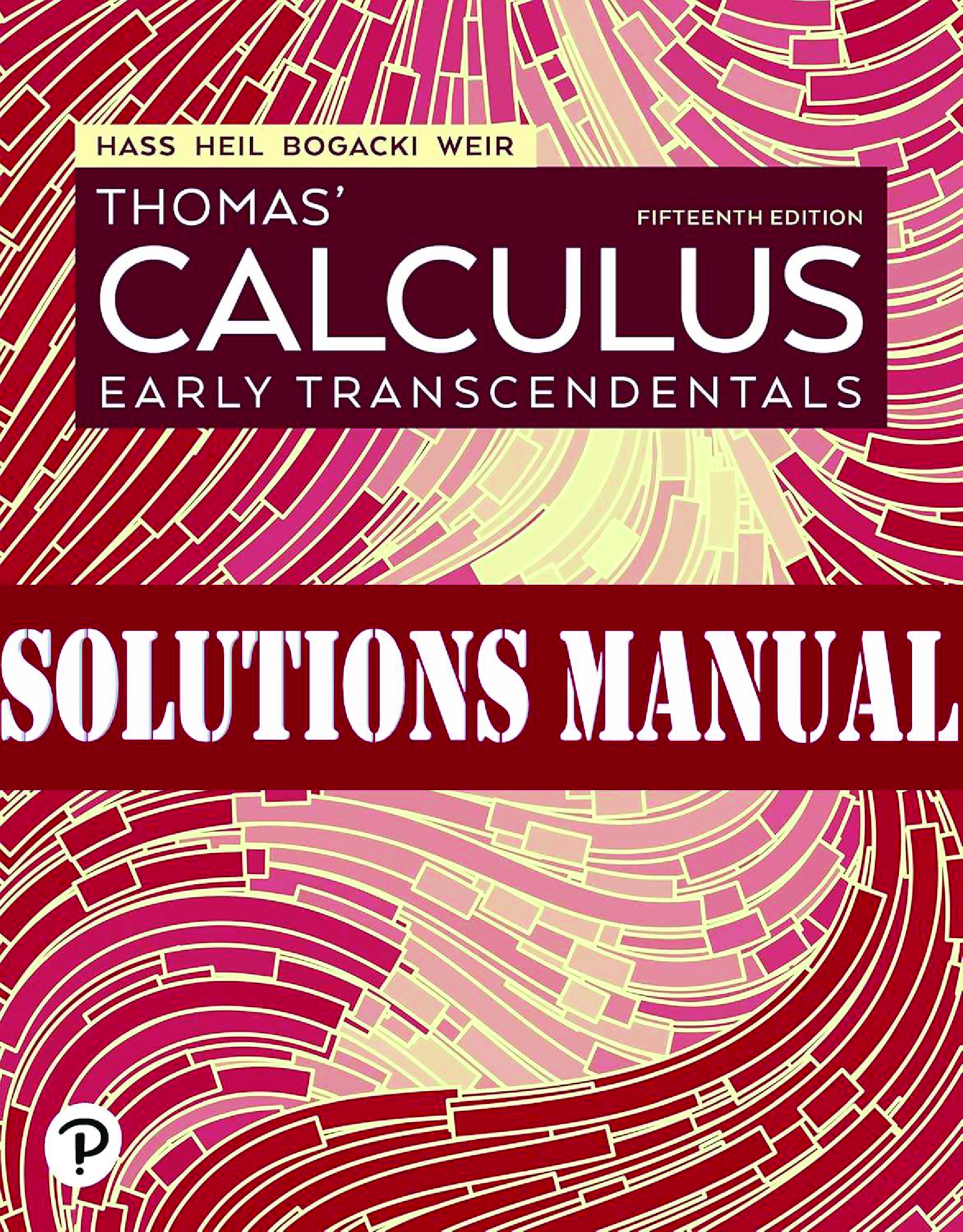
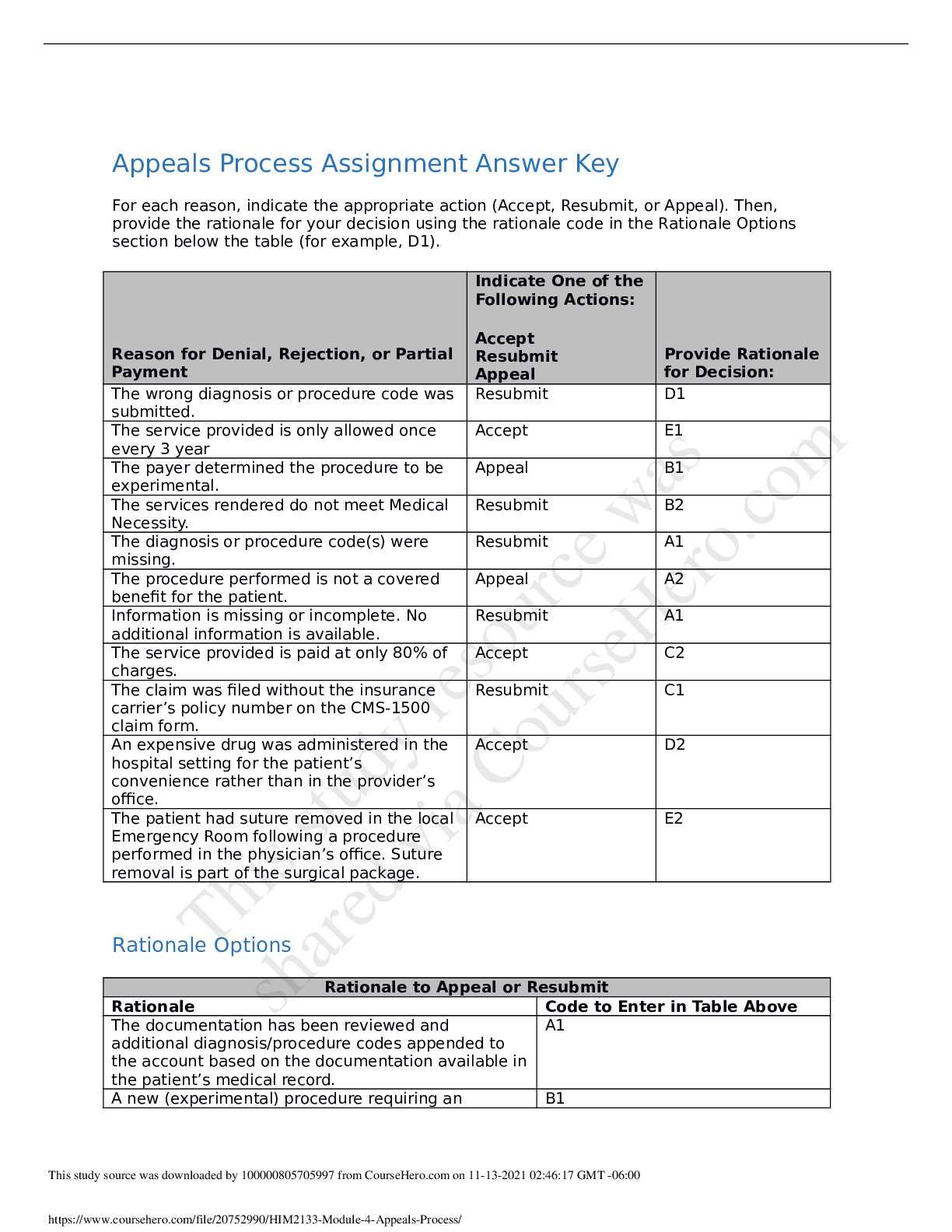
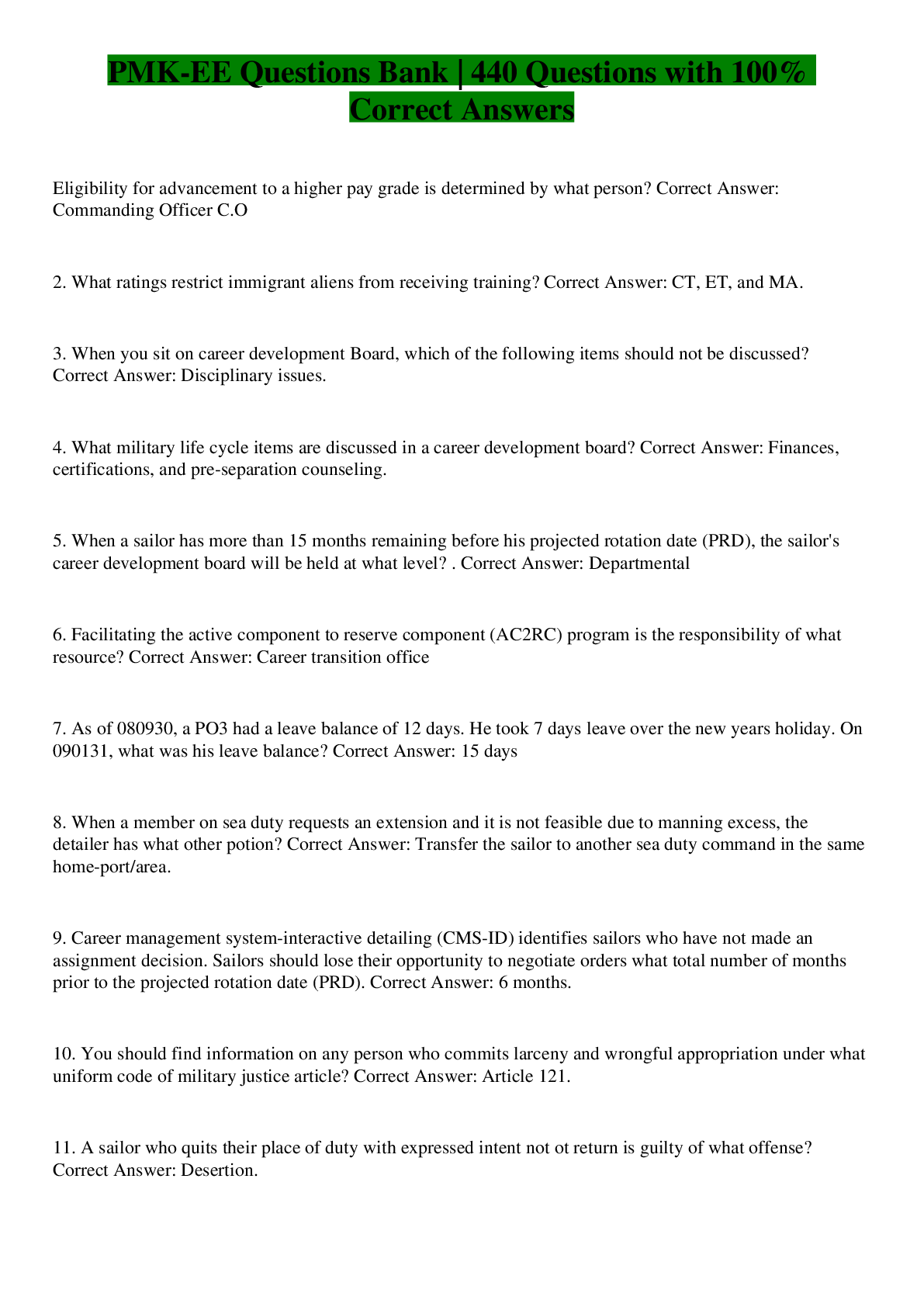

.png)



